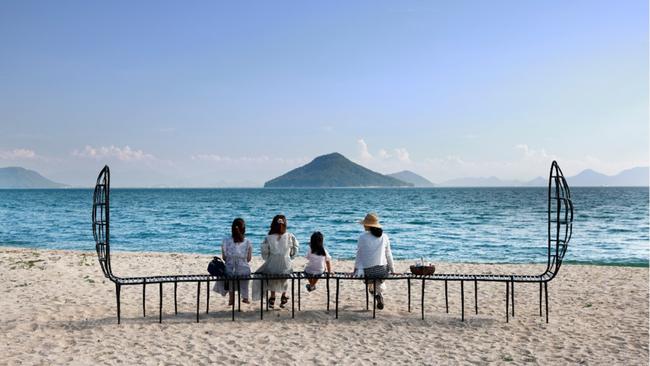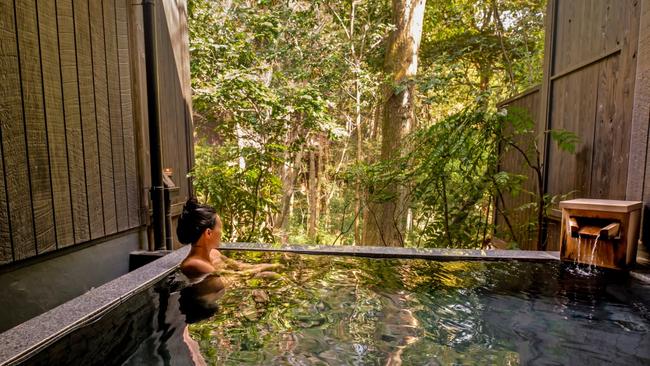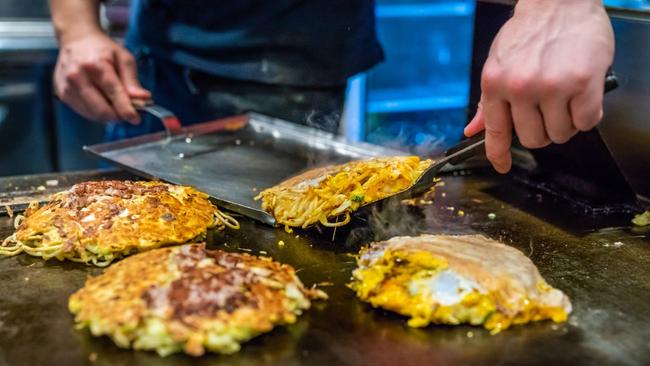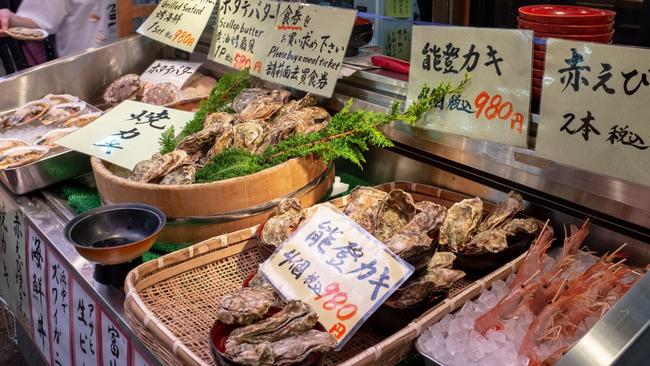An expat’s guide to Japan’s best experiences beyond Tokyo
Tokyo's bright lights, crowds of tourists and big city prices can be overwhelming. But venture beyond the capital and you'll discover a treasure trove of only-in-Japan experiences.
Lifestyle
Don't miss out on the headlines from Lifestyle. Followed categories will be added to My News.
I have a thing for ferries. Not the stomach-churning Devon to France crossings as a kid in the UK, bunged in the back of a Ford Escort with the cornflakes and tea bags. But the little ferries that crisscross Japan’s Seto Inland Sea, gliding slowly over calm water, the sun warming the deck.
Ferry hopping there on a recent trip, I visited the small islands taking part in the Setouchi Triennale art festival. After a month spent desk-bound at home in Tokyo, it was the perfect antidote to big-city life.
On Teshima – population 900 – Tokyo’s traffic noise was replaced by birdsong and the lapping of waves on the beach. On the even tinier Ogijima, passers-by said hello and local cats came hunting for tickles. The art installations were brilliant too.
It all served as a reminder that Japan has so much more to experience beyond the capital. Here are eight of the best things to do in Japan when you venture outside Tokyo.

1. STAY IN A TRADITIONAL RYOKAN
Head to an onsen town and you are most likely going to be staying at a ryokan. They can vary from plush inns with a contemporary shine to historic properties that creak underfoot, but tend to share certain traits. Think tatami mat guestrooms with minimalist Japanese interiors; carefully presented multi-course dinners featuring in-season produce; attentive service from kimono-clad staff; and some form of public hot-spring bath.
Not that ryokan are only found in onsen towns. In central Kyoto, you could splurge on the 200-year-old Hiiragiya, which has welcomed VIPs like Charlie Chaplin and Elizabeth Taylor. Equally luxurious are properties around Japan run by Hoshino Resorts, whether traditional like their Kai ryokans or more modern like the five-star Hoshinoya hotels.
At the other end of the spectrum, try aminshuku, a traditional-style B&B that can be thought of as a super-no-frills ryokan. If you visit Teshima for the upcoming instalments of the Setouchi Triennale in August and October, the island has created a network of minshuku in family homes.

2. LEARN THE LANGUAGE
A few words of Japanese – no matter how badly you mangle the pronunciation – can go a long way to leaving a good impression in Japan.
For the most basic greeting, konnichiwa (hello) is a useful first word to learn, although you could up your game with ohayo gozaimasu (or ohayo) for “good morning”.
Then there’s the super-handy sumimasen, which can be used to say “excuse me” if you need to squeeze by someone, or “sorry” if you shin them with your luggage in the process. It’s also the word many people say when they want to get a waiter’s attention.
Speaking of restaurants, you can say oishii desu (it’s delicious) to staff to let them know you are enjoying your meal. Even better, unleash a gochisousama deshita when you are leaving a restaurant. It’s awkward to translate directly into English but has the same effect as saying, “thank you, that was fantastic”.

3. GET NAKED AT AN ONSEN
Strip off for a soak in an onsen and you’ll be indulging in something the Japanese have been doing for at least 1300 years. The mineral-rich hot spring waters aren’t just deeply relaxing, they are also said to have a host of health benefits.
But where to try one? Eighty kilometres southwest of central Tokyo, Hakone is a classic onsen destination, where you’ll find traditional inns with outdoor onsen baths and sometimes views of Mount Fuji. You could also pop to the onsen-focused Hakone Kowakien Yunessun theme park, which mixes swimming pools with traditional onsen and saunas.
Off the international tourist trail at Kinosaki in Hyogo Prefecture, you can wander around in a yukata (robe), stopping for dips in multiple baths around the pretty town centre. If you are feeling brave, the wonderfully rustic baths of Nyuto Onsen in Akita Prefecture still have fully naked mixed-gender bathing.
Wherever you bathe, remember a few key rules. Wash and rinse well in the seated shower area before getting in the communal baths and don’t let your wash towel touch the bath water. Be aware that many onsen still have no tattoo rules that began as anti-yakuza measures. The baths in Kinosaki are a welcome exception.

4. EXPLORE THE GREAT OUTDOORS
Whether you want a good hike or a day unwinding in nature, Japan has something for everyone. In the mountainous Kii Peninsula, people have been walking the forested pilgrimage trails of the Kumano Kodo for more than 1000 years, en route to the sacred Kumano Sanzan shrines and the temples of Mount Koya. You can even stay at some of the latter, including Eko-in, and take part in the temple’s morning rituals.
Looking for a long walk? The Michinoku Coastal Trail runs more than 1000km along the east coast of the Tohoku region, taking in small fishing ports, rugged coastline, and reminders of the devastating 2011 earthquake and tsunami. The country’s newest trail – completed in 2025 – is the Hitachinokuni in Ibaraki, just east of Tokyo, which winds more than 300km through tranquil woods and mountains – ideal for a spot of forest bathing.
With roughly 70 per cent of Japan being mountainous, there’s also no shortage of peaks to conquer. Kamikochi has some of the most scenic and challenging alpine routes, though for bragging rights you could follow the crowds up Mount Fuji during the July 1-September 10 climbing season. At 3776m, it’s Japan’s tallest and most celebrated peak.

5. TRY REGIONAL SPECIALTY DISHES
Maybe this won’t be a surprise in a country known for its love of good food, but every town and city in Japan has a dish or two to be proud of. Sometimes regional specialties are variations on a theme, like the firm noodles and pork bone broth of Hakata ramen in Fukuoka. Maybe it’s a distinctly local dish, such as Hachinohe’s senbei-jiru, where wheat crackers are added to familiar hotpot ingredients until they become al dente. Squeeze into one of the tiny eateries in Miroku Yokocho to try that.
When you get peckish in Osaka, there are savoury okonomiyaki (pancakes) and deep-friedkushikatsu (skewers), both of which go perfectly with a cold beer. In Hokkaido, you could fill up with jingisukaan (mutton barbecue). Then there’s Kobe’s famed beef, served at high-end teppanyaki restaurants like Tor Road Steak Aoyama. Though with Matsusaka beef in Mie and Omi beef in Shiga, there are other great wagyu brands to try in Japan.

6. DISCOVER TRADITIONAL ARTS AND CRAFTS
True, Kyoto can be just as crowded with tourists as Tokyo, but 1000 years as Japan’s capital and cultural centre left the city with an incredible array of arts and crafts.
For an overview, Kyoto Museum of Crafts and Design has a permanent exhibition that details the production processes of more than 70 traditional crafts, including Kyo-yuzen dyeing, Kyo-nui embroidery and Kyo-wagasa umbrellas. Yes, the Kyo in all of those means they are from Kyoto.
For art in situ, you could then stroll over to the Unesco-designated Nanzen-ji temple to check out the priceless screen door paintings depicting tigers on gold-leaf backdrops.
Away from Kyoto, Arita in less-visited Saga Prefecture is one of the country’s most famous pottery towns, home to numerous kilns, ceramics stores, the Kyushu Ceramic Museum, and even a porcelain-focused theme park. A little north of Tokyo, in Tochigi Prefecture, the town of Mashiko is another pottery hotspot worth checking out, especially if you’d like to try one of the town’s many workshops.

7. UNDERSTAND THE WAYS OF THE SAMURAI
Here’s a tip for Shogun fans looking for a samurai fix: look north of Tokyo. Up in Fukushima Prefecture, Aizu Wakamatsu has dubbed itself the samurai city because of a slew of sites connected to the country’s noble warriors. Not least is the reconstructed Tsuruga Castle and the sprawling grounds of the Nisshinkan, where students were taught how to be skilled (and intellectual) samurai. The city even has a festival celebrating a group of teenage samurai who committed ritual suicide after mistakenly thinking Tsuruga Castle had fallen.
Even further north in Akita Prefecture, Kakunodate has some of the best-preserved samurai mansions in Japan, all grouped along a street lined with weeping cherry blossoms. That includes the Aoyagi residence and its collection of samurai armour.
And if you want some kitschy, family fun, there’s Edo Wonderland in Nikko, a theme park designed to look like an Edo-era (1603-1868) town. You can watch ninja shows, learn to wield samurai swords and shuriken, and dress up in period costumes while at it. Touristy? Yes. Fun? Absolutely.

8. EAT THE FRESHEST FISH
You’ll find great seafood everywhere from Hokkaido in the far north to Okinawa way down south, and it goes way beyond just sushi.
Take Hiroshima, where Kanawa is one of many restaurants specialising in the highly prized local oysters – served raw, grilled and deep-fried. Or there’s the city of Kanazawa on the Japan Sea coast, which as well as being a less crowded alternative to Kyoto because of its cultural attractions, is also home to the 300-year-old Omicho Market. Colourful stalls aside, there are dozens of places in the market to grab super-fresh sushi and seafood donburi (rice bowls topped with raw fish) without breaking your budget.
To that you can add the morning markets in Hakodate, Shimonoseki, Osaka, and many other places. In the Gyosai Centre in Aomori, you can buy a bowl of rice, then go from stall to stall adding toppings of tuna, scallops, salmon roe and whatever else appeals.
More Coverage
Originally published as An expat’s guide to Japan’s best experiences beyond Tokyo




